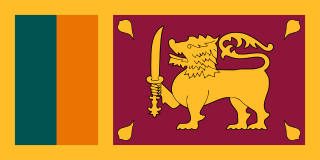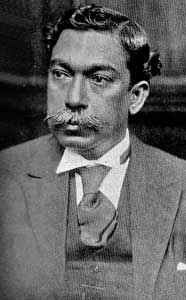
The flag of Sri Lanka, also called the Sinha Flag or Lion Flag, consists of a golden lion holding a kastane sword in its right fore-paw in a maroon background with four gold bo leaves, one in each corner. This is bordered by gold, and to its left are two vertical stripes of equal size in teal and orange, with the orange stripe closest to the lion. The lion and the maroon background represent the Sinhalese race, while the saffron border and four bo leaves represent the concepts of meththa, karuṇā, muditā and upecka respectively. The stripes represent the country's two largest minority ethnicities, with the orange representing the Tamils inhabitants—namely the Sri Lankan Tamils and the Indian Tamils of Sri Lanka—and the teal stripe representing the Sri Lankan Moors. The golden yellow border is a catch-all representing the various minority communities of the country.

The Southern Province of Sri Lanka is one of the nine provinces of Sri Lanka, the first level administrative division of the country. The provinces have existed since the 19th century but did not have any legal status until 1987 when the 13th Amendment to the Constitution of Sri Lanka established provincial councils. It is the 7th largest province by area and is home to 2.5 million people, the 3rd most populated province. The province is bordered by Sabaragamuwa Province and Uva Province to the North, Eastern Province to the Northeast, Western Province to the Northwest and the Indian Ocean to the South, West and East. The Province's capital is Galle.

Provinces are the first level administrative divisions of Sri Lanka. Currently, Sri Lanka is divided into 9 provinces. Each province is further divided into districts, which are further divided into divisional secretariats.

Kegalle is a large town in Sabaragamuwa Province of Sri Lanka. It is located on the Colombo–Kandy road, approximately 78 km (48 mi) from Colombo, 40 km (25 mi) from Kandy, 32 km (20 mi) from Kurunegala and 46 km (29 mi) from Avissavella. It is the main town in the Kegalle District, which is one of two districts which comprise Sabaragamuwa Province. The town is governed by an Urban Council.

The flag of Tamil Eelam was designated as the national flag of the proposed state in 1990. The tiger symbol of the Liberation Tigers of Tamil Eelam (LTTE) was created in 1977, differentiating it from the LTTE's emblem by leaving out the letters inscribing the movement's name. In 2005, the LTTE released a guide providing instructions and explaining the correct usage of the Tamil Eelam Flag. The guide written in Tamil specifies the regulations for flying alone or with national flags of other countries, and for general handling of the flag. The flag has four colours: yellow, red, black, and white. It is banned in Sri Lanka and is often seen at protests and functions concerning Tamil Eelam nationalism around the world.

The National Emblem of Sri Lanka is used by the State of Sri Lanka and the Sri Lankan government in connection with the administration and government of the country. The current emblem has been in use since 1972 and created under the ideas and guidance of Nissanka Wijeyeratne. At the time, he was Permanent Secretary to the Ministry of Cultural Affairs and Chairman of the National Emblem and Flag Design Committee. The designer of the emblem was Venerable Mapalagama Wipulasara Maha Thera, and the artwork was by S. M. Seneviratne.

Edward Walter Perera was a Ceylonese barrister, politician and freedom fighter. He was known as the "Lion of Kotte" and was a prominent figure in the Sri Lankan independence movement, served as an elected member of the Legislative Council of Ceylon and the State Council of Ceylon.

The following outline is provided as an overview of and topical guide to Sri Lanka:
This is a list of the Flags of the Sri Lankan Provinces. Provincial flags for the modern provinces of Sri Lanka were first introduced in 1987, and 1988 for the North Eastern Province, which was at the time one entity. In 2007 with the separation of the North Eastern Province, into the Northern and the Eastern provinces, two new flags were adopted.

The flag of Northern Province was adopted for the Northern Province of Sri Lanka on 22 May 2007.

The Kingdom of Tambapaṇṇī was the first Sinhalese kingdom in Sri Lanka. Its administrative centre was based at Tambapaṇṇī. It existed between 543 BC and 437 BC. According to the Mahavamsa, the Kingdom was founded by Prince Vijaya and his followers.

Northern Provincial Council is the provincial council for the Northern Province in Sri Lanka. In accordance with the Sri Lankan constitution, NPC has legislative power over a variety of matters including agriculture, education, health, housing, local government, planning, road transport and social services. The constitution also gives it powers over police and land but successive central governments have refused to devolve these powers to the provinces. NPC has 38 members elected using the open list proportional representation system.

The flag of Central Province, was adopted for the Central Province of Sri Lanka on 14 November 1987.

The flag of Eastern Province, was adopted for the Eastern Province of Sri Lanka on 22 May 2007.

The flag of Sabaragamuwa Province was adopted for the Sabaragamuwa Province of Sri Lanka in 1987.

The flag of Western Province, was adopted for the Western Province of Sri Lanka in 1987.
Wariyapola (වාරියපොල) is a town in the Kurunegala District, North Western province, Sri Lanka. Wariyapola is 94 metres (308 ft) above the sea level. Wariyapola is mostly known by sri Lankans because of the Wariyapola Sri Sumangala Tero, who take down the Union Jack and re-hoisting the Sinhalese lion flag, before the convention that handed over control of the island to the British in 1815.
The following lists events that happened during 1996 in Sri Lanka.
The following lists events that happened during 1999 in Sri Lanka.
Mudaliar Ahamed Lebbe Sinne Lebbe, also known as Ahamedlebbe Sinnalebbe, was a former Ceylonese headmen and Member of Parliament representing Batticaloa District.














